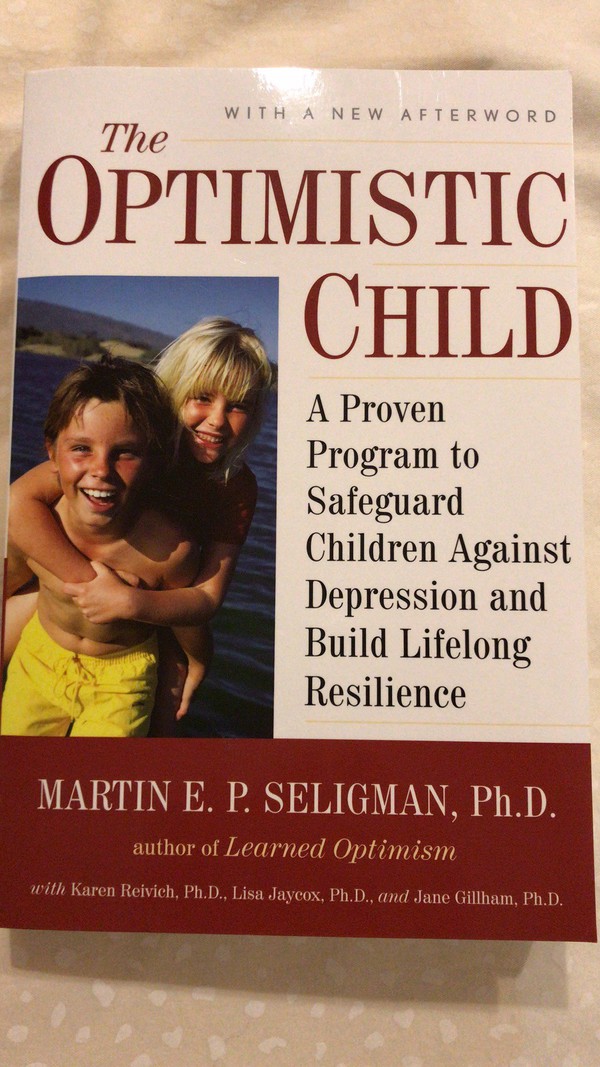读书笔记:乐观的孩子
anonymous-104090 03/04 49244.0/1

Book report: The Optimistic Child: A Proven Program to Safeguard Children Against Depression and Build Lifelong Resilience by Martin E. P. Seligma
In his book Thinking, Fast and Slow, Nobel laureate and renowned psychiatrist Dr. Daniel Kahneman says if you could wish for something for your child, wish for optimism. In this book The Optimistic Child, the author, Martin Seligma, introduces the concept of “accurate optimism,” and explains how it helps people develop resilience. So if I could wish for my children, I would wish them accurate optimism with a growth mindset.
What is optimism? Seligma defines optimism as the way one thinks about causes, a personality trait he calls “explanatory style.” There are three dimensions that one uses to explain why something good or bad happens to him: permanence, pervasiveness, and personalization. Setbacks and difficulties are a natural part of life. An optimistic view of a setback is that the setback is regional, temporary, changeable, and (partially) due to circumstances. A pessimistic view of a setback is that the setback is permanent, pervasive, and due to a personality trait. For example, suppose you fail a math exam. The pessimistic explanation would be “I am stupid (personality trait), I am not good at anything (pervasive), I am doomed for life (permanent).” In comparison, an optimistic explanation would be “I did not study hard enough for this particular exam (temporary). I do not know this geometry chapter very well (regional). This exam was harder than others; most students did not do well (circumstances).”
What is accurate optimism? In Seligma’s definition, accurate optimism is not chanting empty happy thoughts to yourself (e.g., “I am special”, “it will get better”). Accurate optimism does not mean denying or avoiding negative emotions. Accurate optimism means knowing yourself, and being to be curious about your theory of yourself and of the world. Take responsibility, yet do not not to blame everything on yourself. Accurate optimism means taking an active stance in your own world and shaping your life. It is an excellent defense against depression and a great strategy for building resilience.
This kind of (accurate) optimism is both innate and learned. As parents, we can teach our children to be optimistic. Contrary to common beliefs, optimism does not come from “being encouraged by others, teachers or parents, regardless of performance”. One gains optimism by mastering skills, overcoming difficulties, and experiencing personal achievement. This message strikes home for me and more or less hits a sore spot in the US education system (as discussed in the book). I am a true believer that one grows when he overcomes challenges. True confidence and self-esteem do not come externally, from (vain) praise and encouragement; they grow internally, from hard work and overcoming challenges. As parents and teachers, it is our job to encourage our children and foster their resilience -- to help them set appropriate goals, teach them how to break a seemly daunting task into smaller concrete steps, remind them of their own successes when facing setbacks, and nudge them when they feel reluctant to try again.
With the mindset that optimism can be learned and taught, the book goes on to provide detailed instructions on how to teach ourselves and our children optimism. There are basically four essential skills of optimism. The first is “thought catching” - learning to recognize the thoughts that flit across your mind when you feel the worst (e.g., thinking “I am dumb” after receiving a low grade on an exam). The second is evaluating these automatic thoughts and recognizing that the things you say to yourself are not always accurate. As the book says, be your own Sherlock Holmes: analyze and find evidence (e.g., you get As in some very tough courses, you play chess really well) that will support different beliefs. The third skill is generating more accurate and possibly multiple explanations for a bad event. For example, “This exam was harder than usual, as most students failed it. I played video games instead of studying.” The fourth skill is decatastrophizing. Catastrophizing is focusing on the worst case (e.g., you will fail the course, get a poor GPA, not get into a college, and have a miserable life.). Decatastrophizing means understanding what the worst case is, whether it is likely, what is the best case, whether it is likely, what is the most likely case, and how you can make things better.
The book discusses the classic A, B, C model where A is adversity (the stresser), B is your beliefs about what happened and why, and C is consequences, i.e., how you feel and what happens after. It is not A that makes you feel bad; it is actually B that contributes more to C. Having the right explanatory style means appropriately explaining the crucial B.
The book talks about boosting problem solving and social skills. The problem solving skills consist of five steps: 1. Slow down: stop and think; 2. Take the other person’s perspective; 3. Go for the goal; 4) Set and choose plans of action; and 5) Get feedback. The book focuses on being assertive without being too pushy when discussing social skills: explain your feelings, do not blame, and explain what you need now, similar to what the book Nonviolent Communication teaches.
The books concludes with a cautionary note. Optimism is not a cure-all. It is no substitute for good parenting, hard work, motivation, and strong ethics. Optimism is merely a tool, though a powerful one that fosters resilience in youth and ourselves.
Last, I want to share my two cents. The book discusses general principles. There are definitely extreme cases, such as Steve Jobs and Elon Musk, who are probably extraordinarily optimistic with a distorted reality field. Although inspiring, extremes can be poor guidance principles and stories based on them are subject to survival bias. For example, Steve Jobs dropped out of college and succeeded, but we do not see the many who dropped out of college and failed. So dropping out of college is probably a bad idea for college-age students in general.
Practicing these principles can be challenging. Consider a tennis tournament. Let’s assume you are using the correct right game strategy and you are as good as your opponents. But you have lost three games in a row. Can you still view your tennis ability objectively and continue to apply your (correct) strategy? It is easier said than done. Only those who have been there and pushed through can have that confidence. The Warriors definitely showed us this last year when they had lost a few games in a row, but still had the confidence to carry on with their game strategy to win the NBA Finals.
The book was recommended to me by 雷春。I finished the book in one sitting. What I value most is the lesson about how to help a pessimistic person to quarantine self-criticism, evaluate it more objectively, identify multiple aspects of an event, and take action. That is the take-home message of this wonderful and pragmatic book.


